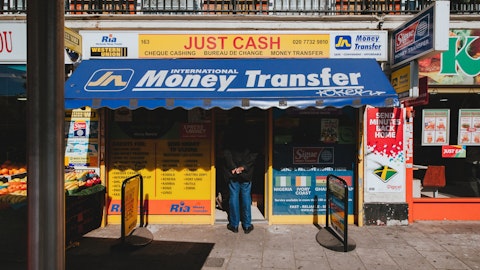We’ve got over 20 in the pipeline now that are very attractive opportunities for us, ISVs of all different sizes, all different vertical markets. The commonality is really around that boarding experience that they’re looking for as well as specific funding requirements they may have, and in understanding that it’s difficult for software companies to become payments companies. And obviously, the Profac model tries to solve for that. And I think it does it very well.
William Nance: Got it. Appreciate that. And then just maybe a follow-up question on some of the October trends. It sounds like you guys are funding to relatively consistent consumer spending trends. I think we’re 4 for 4 of large-cap payments companies making similar comments. And I think particularly the networks have still put out numbers calling out a deceleration from September to October, and I think there’s some abstracts around why that’s happening. But just maybe you could kind of talk to your perspective of what do you think is kind of causing that disconnect and should investors be more focused on the slight tick down or the relatively consistent commentary heading into the remainder of the year? Thanks.
Cameron Bready: Yes. It’s a good question, Will. We tried to call out over a long period of time, there’s never going to be sort of exact correlation between any particular acquirer, sort of mix of business and what the networks represent. The networks represent the market more broadly as it relates to the brands that they serve in the marketplace. So there’s always going to be differences between their fundamental performance and what we’re seeing in our business. I think as it relates to our volume, we’ve seen consistent trends kind of Q3 through October as we called out in our prepared remarks today, there’s reasons that the networks may be saying something different in their business. They’ve got travel comps than we may have in our business.
And generally, they may have more fuel exposure in their business than we have in our business. So I think that’s one thing that they called out as a reason for volume slightly ticking down in October relative to Q3 performance in their underlying businesses. So there’s always going to be some degree of difference between what we’re seeing in underlying trends and what the networks may be seeing as well.
William Nance: Very helpful and encouraging. Thanks for taking the questions and that’s all for today.
Operator: Thank you. Our final question this morning comes from the line of Tien-Tsin Huang with J.P. Morgan. Please proceed with your questions.
Tien-Tsin Huang: Hi, thanks. I’ll keep it quick. I appreciate the time. Just on the point of sale software front, I appreciate all the disclosures there. Can you just remind us how big the sales force is, do you have a geographic coverage that you want, I know it’s complementary to your dealer network? And then also just I’m assuming that the sales force is trained and compensated to sell these value-added services like payroll at this point, they’re in a good productive place? That’s all I had. Thank you.
Cameron Bready: Yes, really good question, Tien-Tsin. So as we called out in our prepared remarks earlier, in the U.S. market we go to market through a dealer channel, which is about 300 dealers that cover most of the major markets across the U.S. and Canada as well. And then we have somewhere in the neighborhood of, call it, 1,700 sales professionals who either can sell POS directly or refer POS sales into a specialist who can sell that. So we’ve tried different combinations as go-to-market from a sales and distribution matter around selling more software. We typically have gone to what I would call somewhat a hybrid model, where we do certify certain RMs to be able to sell POS capabilities. They have to be certified to sell those into the marketplace.
But we allow all of our sales professionals, and we compensate them, of course, as well to refer business into those specialists as well. So that relationship, I think whether it’s payroll or whether it’s point of sale, I think that distribution model has served us well. And I think, generally, it’s a good model for us to continue to leverage as we move forward, which means we have lots of distribution, obviously, to be able to push product through in North America. In markets outside of the U.S., I would say the point-of-sale system that we talked about, GP POS, is a little simpler solution. It’s easier to sell. It’s less complex. So generally, we can push that through the various distribution channels that we have as well as through FI partner distribution as well in international markets in which we operate.
So there’s really good distribution, I think, capability for us being able to sell our point-of-sale capabilities over time. Obviously, a more sophisticated sale is going to require a more specific specialist who focuses exclusively on POS sales. We’re at the smaller end of the market. Most of our sales professionals are going to be able to sell our GP POS solution.
Tien-Tsin Huang: That’s perfect. Thank you. Appreciate it.
Cameron Bready: Thanks Tien-Tsin. And that concludes our call for this morning. I want to take a moment just to thank you for your interest in Global Payments, and thank you for joining us today. I hope everyone has a happy Halloween. Take care.
Operator: Thank you. This concludes today’s conference call. You may now disconnect your lines at this time, and have a wonderful day.
Follow Global Payments Inc (NYSE:GPN)
Follow Global Payments Inc (NYSE:GPN)
Receive real-time insider trading and news alerts





